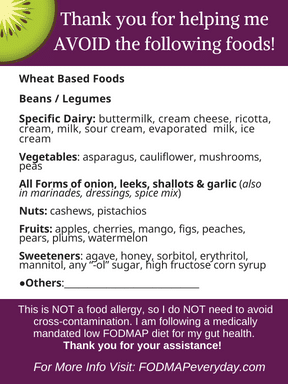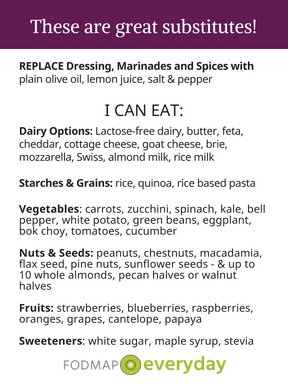Prepare In Advance
You’ve been on the FODMAP elimination diet for a week or so and things are going great, but then a friend invites you to dinner or your boss offers to take you out to lunch.
Following the low FODMAP diet when going out to a restaurant can be daunting, but that doesn’t mean you have to miss out on the pleasure of dining out!
With a little bit of prep work, you can enjoy dining out on the low FODMAP diet. Calling ahead, researching the menu, and arming yourself with the right questions will ensure there’s something on the menu you can enjoy.
Plus, being prepared can reduce anxiety or stress, which can exacerbate IBS symptoms for some people.

Before You Arrive
-
- Check out the menu online – many restaurants have their menus available on their websites. Scope out some dishes that appear to be low FODMAP.
- Call ahead – Even if you can access the menu online, it’s helpful to give the restaurant a heads up about your dietary restrictions. If they don’t sound accommodating, you may want to find another restaurant!
- Consider restaurants that cater to gluten-free and/or dairy-free diets, which may have more suitable options.
- Keep the rest of your meals during the day as low FODMAP as possible to reduce the cumulative effect of FODMAPs on GI symptoms.
How To Ask The Right Questions
Waitstaff, chefs, and managers want diners to have a pleasant experience in their restaurants. Plus many servers nowadays are aware of dietary restrictions and will ask if diners have any allergies or restrictions.
This is a great opportunity to kindly notify your server of your needs. Be polite and friendly, and if you’re comfortable let them know that these restrictions are due to a medical condition and that those foods can make you sick.
In addition to the items you can’t have, give your server an idea of the foods you can have. List proteins, vegetables, fruits, grains, nuts and seasonings that are low FODMAP. If he or she suggests a few options, make sure to ask about any additional sauces, dips or marinades.
Taking a written list of what you can’t have with you to restaurants takes the pressure off of you to remember everything, plus servers can share the list with the chef to verify ingredients in a dish. FODMAP Everyday® has a card you can print and keep (see below!) in your purse or wallet.
Also keep your Monash University Low FODMAP Diet app handy, if possible, for both your own peace of mind as you peruse the menu as well as for any unusual ingredients that might pop up.

What To Look Out For
Probably the most common FODMAPs on restaurant menus are garlic and onions. Sometimes it feels like they’re in everything, regardless of the cuisine.
Make sure your server understands that this includes white, yellow and red onions, shallots, garlic salt and garlic and onion powder. To steer clear of these ubiquitous fructans, ask about sauces, salsas, dips, marinades, and mixed dishes like soups, stews, meatballs, dumplings, etc.
Remember, the low FODMAP diet is not gluten-free or dairy-free so unless you avoid those foods for different reasons, you can have wheat/gluten and dairy in smaller quantities, such as aged cheese in a salad, soy sauce with sushi, or a slice of authentic (slow-fermented) sourdough bread.
If that is too confusing or complicated, you may wish to tell the server you do not eat wheat, dairy, garlic or onions to simplify things.
Also remember that you do not have to worry about cross-contamination, so if a burger comes on a wheat roll and has slices of onion on it and you forget to tell them to leave those behind, you can simply unpack that burger and still enjoy it.
What To Order
What you feel like eating is up to you, but generally speaking, it’s easier to go low FODMAP in a restaurant setting by avoiding mixed dishes that are made ahead of time and not easily modifiable.
For example, it would be impossible to remove garlic or onions from a soup with those ingredients as the base, but you could easily ask for no sauce on your grilled chicken or no onions in your salad. Here are some “safe” dishes that are easier to modify:
-
- Salads with low FODMAP veggies (eg leafy greens, carrots, cucumber), nuts or seeds (walnuts, pine nuts, etc.), and salmon, tuna, chicken or a ¼ cup (42 g) of chickpeas
- Grilled or roasted fish, chicken, pork or beef with low FODMAP veggies (eg green beans, zucchini) and rice or quinoa. Avoid marinades or sauces unless you can find out the ingredients.
- Stir-fry firm tofu and low FODMAP vegetables over rice or rice noodles; request onion and garlic-free sauces on the side
- Sushi/sashimi with fish or seafood and white or brown rice with soy sauce. The small amount of wheat in soy sauce is ok for the low FODMAP diet; if needed, ask for wheat-free tamari
- Omelette or frittata with a side of roasted potatoes or hash browns (no onion or garlic)

Below are tips for ordering and low FODMAP dishes at Italian, Mexican and Indian restaurants.
Italian
-
- Start with gluten-free pasta with olive oil or simple tomato sauce (ask about ingredients), low FODMAP veggies such as bell pepper, spinach, basil, olives and optional fish or seafood
- Gluten-free pizza crust with olive oil or simple tomato sauce (ask about ingredients), low FODMAP veggies such as bell pepper, spinach, cherry tomatoes, basil and low FODMAP cheese
- Low FODMAP cheeses include parmesan, pecorino, goat cheese, ricotta and mozzarella (be mindful of portion sizes!)
- Polenta with simple tomato sauce (ask about ingredients) and roasted chicken (ask about seasonings)
- Grilled octopus or calamari with roasted potatoes
- Salmon with sauteed cherry tomatoes and fennel (< ½ cup)
- Crudo (raw fish) with olive oil, citrus & salt
- Arugula salad with prosciutto, olive oil, lemon juice, salt & pepper
Mexican
-
- Grilled fish tacos with corn tortillas, cabbage, chopped tomato, a few slices avocado and/or mayonnaise
- Chicken, steak, fish or shrimp fajitas (ask for no onion or garlic; herbs like cilantro are fine) with low FODMAP veggies (peppers, zucchini, tomatoes), rice & corn tortillas
- Elote (limit to ½ an ear of corn – about ⅓ cup), topped with cotija cheese, lime juice, mayonnaise, cilantro & red chili)
- Plain tamale with shredded chicken, pork or beef (ask for no marinade)
- Jicama sticks and tortilla chips
- Salad with lettuce, tomato, a few slices avocado, olive oil and vinegar or lemon/lime juice
Indian
-
- Ask if the restaurant has a Jain menu as these dishes exclude garlic and onions; asafoetida (hing) and other spices (cumin, coriander, turmeric, etc.) are used for flavor
- Avoid roti, chappatis, naan and samosas as these are all made with wheat (fructans)
- Fish or shrimp tikka (baked in a tandoor oven) – ask for no onions or garlic in the marinade, serve with basmati rice and cucumber & tomato salad
- Masoor dal (red lentils tempered with spices such as cumin, mustard seeds or curry leaves) – ask for no onions or garlic; limit to ¼ cup serving and mix with basmati rice
After Elimination Phase It Gets Easier
The recommendations above are for the most restrictive low FODMAP diet. Dining out on the low FODMAP diet does get easier, especially after the Elimination and Challenge/Reintroduction phases.
After your Challenge Phase you may find that you’re not sensitive to the fructans in garlic or onions, or that you can tolerate a small amount, in which case a few spoonfuls of salsa on your tacos or Caesar dressing on your salad may be fine!
You know your body best and as you become more aware of which foods cause your symptoms, you’ll be able to make more confident decisions when dining at a restaurant.
Also, keep in mind one meal that may be higher in FODMAPs doesn’t mean you’re going to have an adverse reaction, so relax, enjoy your meal, and stick to low FODMAP meals before and after.
Handy Card!
To help make it a bit easier to communicate to your waiter and the restaurant kitchen staff about your dietary restrictions you can download and print out this card – using both or just the AVOID side of the card.
We suggest either making a few you can give out as you dine out – or one you laminate and keep in your wallet or purse and hand to the waiter as they ensure your meal is safe to eat. These cards are 3″ x 4″. The size of a standard index card. We suggest printing to card stock.
Just click on the image to download the PDF to your computer for printing.
See our TOP 10 STRATEGIES FOR EATING OUT ON THE LOW FODMAP DIET.









